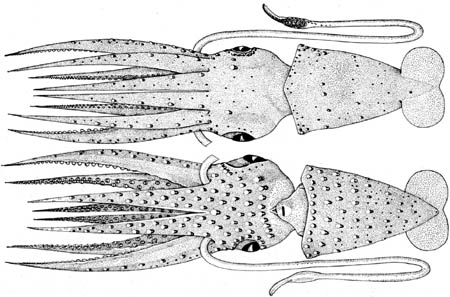Histioteuthis eltaninae
Richard E. Young and Michael VecchioneIntroduction
H. eltaninae has a circumglobal distribution in subantarctic waters where it is the most common histioteuthid taken. The largest male known is 105 mm ML and the largest female, 98 mm ML.
Characteristics
- Photophores
- Large, compound photophores without (?) posteriorly directed reflectors.
- Arms IV with 3 longitudinal series on arm base.
- Terminal group of large photophores on arms absent.
Comments
More details of the description can be found here.Species of the reversa-group are distinguished by the following characters:
- Compound photophores
- Large and small (see white arrows in photograph above) photophores intermixed on ventral surface of mantle .
- 18 photophores (1 large and 1 small) around right eyelid.
- Beak
- Weakly developed median ridge on each lateral wall.
- Tubercles
- Absent.
H. eltaninae is most easily separated from other members of the reversa group by (1) the arrangements of photophores on arms IV (4 series in H. atlantica and H. reversa but 3 series in H. eltaninae) and (2) from H atlantica by the absence of special arm-tip photophores and from H. reversa by the long connective complex in their spermatophores. If the dorsal (i.e., the 4th series) series of photophores in H. reversa has been lost due to damage, the number of photophores in the third series will separate the species: H. reversa has 5-8 while H. eltaninae has 2 or 3 (Voss, 1969).
We examined the mantle photophores of the holotype for the presence of posterior reflectors. Although the tissue was badly faded, no trace of the reflector could be found. Except for data on the posterior reflector on compound photophores, the above information is from Voss (1969) and Voss, et al. (1998).
Life History
Males mature at 66-105 mm ML. Size at maturity in females is unknown. Largest known female is 98 mm ML. (Data from Voss, et al., 1998)
Distribution
Geographical distribution
Type locality: 40° 05'S, 149° 55'W. The northern distributional boundary of H. eltaninae is the region of the Southern Subtropical Convergence. In some areas it strongly overlaps the distribution of its close relative H. atlantica (Voss, et al., 1998).
References
Voss, N. A. 1969. A monograph of the Cephalopoda of the North Atlantic: The family Histioteuthidae. Bull. Mar. Sci., 19: 713-867.
Voss, N.A., K. N. Nesis, P. G. Rodhouse. 1998. The cephalopod family Histioteuthidae (Oegopsida): Systematics, biology, and biogeography. Smithson. Contr. Zool., 586(2): 293-372.
Title Illustrations

| Scientific Name | Histioteuthis eltaninae, Histioteuthis eltaninae (2) |
|---|---|
| Reference | from Voss, N. A. 1969. A monograph of the Cephalopoda of the North Atlantic: The family Histioteuthidae. Bull. Mar. Sci. 19:713-867. printed with permission |
| Sex | f, f (2) |
| View | ventral, dorsal (2) |
| Size | 53 mm ML, 53 mm ML (2) |
| Type | holotype, holotype (2) |
| Copyright | © 1962 Bulletin of Marine Science |
About This Page
Drawing from Voss (1969) printed with the Permission of the Bulletin of Marine Science.

University of Hawaii, Honolulu, HI, USA

National Museum of Natural History, Washington, D. C. , USA
Page copyright © 2013 and
 Page: Tree of Life
Histioteuthis eltaninae .
Authored by
Richard E. Young and Michael Vecchione.
The TEXT of this page is licensed under the
Creative Commons Attribution-NonCommercial License - Version 3.0. Note that images and other media
featured on this page are each governed by their own license, and they may or may not be available
for reuse. Click on an image or a media link to access the media data window, which provides the
relevant licensing information. For the general terms and conditions of ToL material reuse and
redistribution, please see the Tree of Life Copyright
Policies.
Page: Tree of Life
Histioteuthis eltaninae .
Authored by
Richard E. Young and Michael Vecchione.
The TEXT of this page is licensed under the
Creative Commons Attribution-NonCommercial License - Version 3.0. Note that images and other media
featured on this page are each governed by their own license, and they may or may not be available
for reuse. Click on an image or a media link to access the media data window, which provides the
relevant licensing information. For the general terms and conditions of ToL material reuse and
redistribution, please see the Tree of Life Copyright
Policies.
Citing this page:
Young, Richard E. and Michael Vecchione. 2000. Histioteuthis eltaninae . Version 01 January 2000 (under construction). http://tolweb.org/Histioteuthis_eltaninae/19790/2000.01.01 in The Tree of Life Web Project, http://tolweb.org/








 Go to quick links
Go to quick search
Go to navigation for this section of the ToL site
Go to detailed links for the ToL site
Go to quick links
Go to quick search
Go to navigation for this section of the ToL site
Go to detailed links for the ToL site